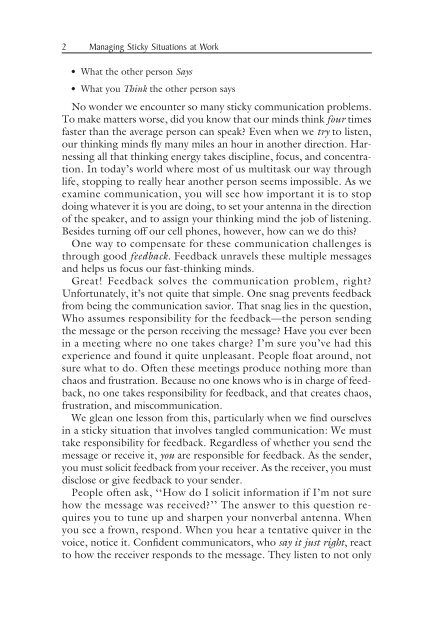Managing Sticky Situations at Work
Managing Sticky Situations at Work
Managing Sticky Situations at Work
You also want an ePaper? Increase the reach of your titles
YUMPU automatically turns print PDFs into web optimized ePapers that Google loves.
2 <strong>Managing</strong> <strong>Sticky</strong> <strong>Situ<strong>at</strong>ions</strong> <strong>at</strong> <strong>Work</strong>• Wh<strong>at</strong> the other person Says• Wh<strong>at</strong> you Think the other person saysNo wonder we encounter so many sticky communic<strong>at</strong>ion problems.To make m<strong>at</strong>ters worse, did you know th<strong>at</strong> our minds think four timesfaster than the average person can speak? Even when we try to listen,our thinking minds fly many miles an hour in another direction. Harnessingall th<strong>at</strong> thinking energy takes discipline, focus, and concentr<strong>at</strong>ion.In today’s world where most of us multitask our way throughlife, stopping to really hear another person seems impossible. As weexamine communic<strong>at</strong>ion, you will see how important it is to stopdoing wh<strong>at</strong>ever it is you are doing, to set your antenna in the directionof the speaker, and to assign your thinking mind the job of listening.Besides turning off our cell phones, however, how can we do this?One way to compens<strong>at</strong>e for these communic<strong>at</strong>ion challenges isthrough good feedback. Feedback unravels these multiple messagesand helps us focus our fast-thinking minds.Gre<strong>at</strong>! Feedback solves the communic<strong>at</strong>ion problem, right?Unfortun<strong>at</strong>ely, it’s not quite th<strong>at</strong> simple. One snag prevents feedbackfrom being the communic<strong>at</strong>ion savior. Th<strong>at</strong> snag lies in the question,Who assumes responsibility for the feedback—the person sendingthe message or the person receiving the message? Have you ever beenin a meeting where no one takes charge? I’m sure you’ve had thisexperience and found it quite unpleasant. People flo<strong>at</strong> around, notsure wh<strong>at</strong> to do. Often these meetings produce nothing more thanchaos and frustr<strong>at</strong>ion. Because no one knows who is in charge of feedback,no one takes responsibility for feedback, and th<strong>at</strong> cre<strong>at</strong>es chaos,frustr<strong>at</strong>ion, and miscommunic<strong>at</strong>ion.We glean one lesson from this, particularly when we find ourselvesin a sticky situ<strong>at</strong>ion th<strong>at</strong> involves tangled communic<strong>at</strong>ion: We musttake responsibility for feedback. Regardless of whether you send themessage or receive it, you are responsible for feedback. As the sender,you must solicit feedback from your receiver. As the receiver, you mustdisclose or give feedback to your sender.People often ask, ‘‘How do I solicit inform<strong>at</strong>ion if I’m not surehow the message was received?’’ The answer to this question requiresyou to tune up and sharpen your nonverbal antenna. Whenyou see a frown, respond. When you hear a tent<strong>at</strong>ive quiver in thevoice, notice it. Confident communic<strong>at</strong>ors, who say it just right, reactto how the receiver responds to the message. They listen to not only















